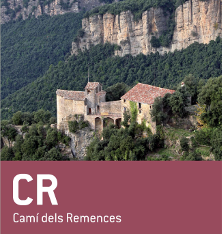The revolt of the Remences – a peasant uprising against their lords and the abusive mals usos (feudal obligations) - took place in La Garrotxa during the second half of the 15th century.
One of the most outstanding reminders of this period is the castle of Hostoles that, according to the historian Vicenç Vives, is “the most notable mountain fortress of the Remença resistance”. Today, this castle is the focal point for understanding this revolt, led by Francesc de Verntallat from the village of El Mallol in LaVall d’en Bas.
This route takes you through the Hostoles and Bas valleys and onto Santa Pau, following in the footsteps of the Remença peasants as they fought for their freedom. This route begins in La Vall d’en Bas in the village of El Mallol, sat astride one of the most notable rocky outcrops in this otherwise flat valley. The house of the Veguer, the prison or Notari house, as well as the farmhouse where Francesc de Verntallat was born, are some of the most significant buildings preserved in this village. A plaque reminds visitors of the connection between El Mallol and Francesc de Verntallat and at the entrance to the village of Hostalets a further monument to this peasant leader can be seen.
The next stop on this route is Sant Feliu de Pallerols, where in the old centre of this town (the old sagrera) you can see the house in which Francesc de Verntallat died. Also of interest in this town is the mill Molí de la Conqueta, where the peasants who decided to rebel against the abuses they were subjected to by their feudal lords once worked so ceaselessly. Within the limits of the municipality of Sant Feliu de Pallerols lies the castle of Hostoles, the main fortification in the valley and one the principal strongholds of the feudal system in the valley. Francesc de Verntallat took and converted the castle – today in ruins – into his headquarters during the first Remença revolt, and it was to remain in the hands of the rebels until after the second Sentence of Guadalupe. Today, the only visible remains of this symbol of Catalan history, documented from 1020, are parts of the walls, part of the main cylindrical tower and the cistern.
The castle of Hostoles and those of Puig-alder and Colltort stood on the frontier between the countdoms of Besalú and Girona: Puig-alder, also in the municipality of Sant Feliu de Pallerols, is mentioned in 1020 in the testament of Bernat Tallaferro and by 1184 a church dedicated to Sant Salvador had also been built on the same lofty site. Restored a few years ago, attached to the church there is a small building where people can sleep and from where there are splendid views across the valleys of Vallac and Bastons. The castle of Colltort, documented from 1017, also provides splendid views across La Garrotxa. Today, it too is ruined but gazes down over the route to Santa Pau, another of the village in La Garrotxa that was marked by the revolt of the Remences.
Don't miss
·The prison in El Mallol, Colltort castle, the sagrera (old quarter clustered around the church) of Sant Feliu de Pallerols and the rest of its historical centre, and the monument to Francesc de Verntallat in the house he lived at the end of his life (opposite the Molí de la Conqueta).
·The gastronomical tradition of La Garrotxa kept alive by the restaurants of the group Cuina Volcànica.
·A walk through the peaceful village of Mieres, which in September 1484 was the scene of a revolt when the local authorities attempted to put an embargo on the property of the people who refused to pay their taxes to the local lords.











